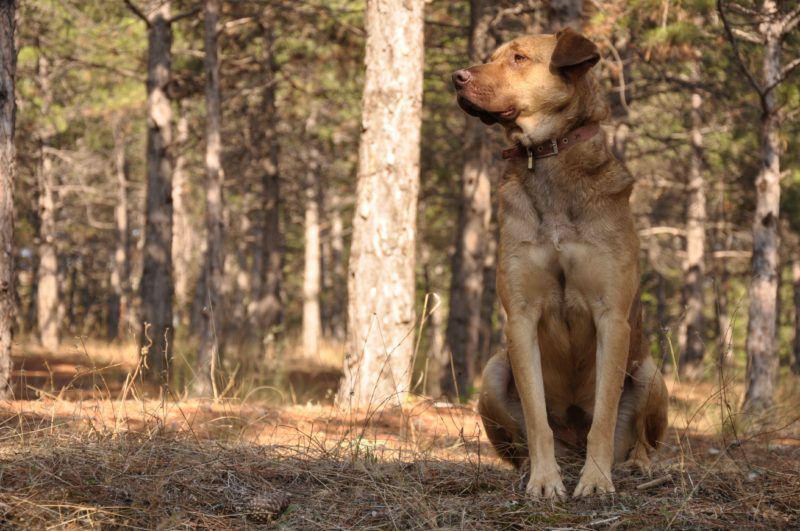Ticks, ew!
Just the mere thought of these devious diseased parasites lurking in the wooded parts of our favorite paths and trails can give us pause.
Although ticks are present year-round, they are most active in the spring and summer months, thus it feels like a game of arachnid roulette anytime we brave the bushy trails to let our four-legged buddies stretch out and run free under the sun.
Over the last 1000 years, these tough little predators have adapted to every climate on every continent, so if you think your area is tick-free, think again. The resilient eight-legged bloodsuckers are built to survive in just about any environment: freezing, pouring rain, or sweltering heat.
What is a tick?
Ticks are part of a group of animals known as arthropods. They are arachnids like spiders, having two main body parts and eight legs, while insects have three main body parts and six legs. There are over 900 species of ticks found throughout the world, of which about 90 are found in the U.S. These consist of hard ticks (Ixodidae), who carry and transmit Lyme disease, and soft ticks (Argasidae), who spread Tick-Borne Relapsing Fever (TBRF), and both need blood meals to grow and are quite well-equipped at getting them.
Note: One distinguishing factor in a hard tick versus a soft tick is that the hard tick’s mouthparts are visible, while soft ticks look almost as if they do not have a mouth. Hard ticks also have what is called a dorsal shield while soft ticks do not.
Yet with 700 types of species of hard ticks and 200 soft ticks, only a few of them bite and transmit disease, although like any natural predator, they know the best places to catch a ride from an unsuspecting traveler; even more, their saliva acts as a numbing agent so that you won’t even feel the bite!
How to Remove Ticks from Dogs
When you spot a tick on your dog (or yourself), do not use your bare hands to remove it, as they carry plenty of bacteria and viruses.
The tick removal process requires three easy steps:
- Grab a pair of tweezers and pinch the head of the tick as close as you can to the host’s skin.
- Once you have a hold of it, pull firmly, carefully, and steadily in an upward motion preferably at a 45-degree angle. Avoid twisting or jerking the tick as it may cause the head/mouth to detach and stay embedded.
- Once the tick is removed, apply a safe disinfectant like iodine or rubbing alcohol to the wound and/or affected area to prevent infection.
While it is as easy as that to remove them once they are discovered, be sure to check your dog regularly for ticks, as well as yourself, and remove them as soon as possible to avoid any secondary diseases. If you are unable to remove the entire head and body from your dog, contact your veterinarian.
How to Prevent Ticks
Like with many things, the best defense against these relentless clingers, is a good offense.
Do regular checks on your dog, especially after walks in tall grassy areas. Ticks like to hang out in moist, or shady spots away from dryness or sun. They prefer bushes and high grasses, or fences and retaining walls; you may find them first in these places, but be assured, if you don’t, they most certainly will find you and your dog.
Even if your four-legged friend is already using tick medication or a preventative collar, it is still good to check yourself and your dog after walks in the wild. And be sure to check your dog from head to toe, especially on the paws and between the toes, then move to the legs, around the eyes, inside the ears, on their lips, under the tail, and near their anus. Check under the collar, basically search for bumps all around and investigate any you find. As well as check yourself all around, everywhere, because sometimes you won’t feel them until they are big, fat, and full of blood; again, they like warm and moist areas, so be sure to check everywhere on your body (think groin, armpits, and scalp).
Create Your Tick-Free Zone
If your dog has a big or small backyard to play and lounge around in, there are a few things you can do to make it safer from ticks.
Cut the grass, the little parasites love to sit and wait for a host to walk by and rub up against the grass so that they can unsuspectedly move on and bite.
Clear out any thick brush or deep vegetation that your dog might chase a ball into, or just forage in for fun.
Don’t let debris pile up, clean up those mounds of branches, sticks, or wood, even dead leaves, and other yard trash make for the ultimate tick bus stops.
If there are permanent tick-prone areas in your yard or on your property like fences or compost, you can build barriers around them to keep the ticks from moving in, such as using gravel to create a complete protection radius.
Other Preventative Measures
Nematodes
Do you want tick payback? These microscopic roundworm soldiers are a parasite’s worst nightmare. Nematodes can serve all sorts of purposes when combating pests, and ticks are on their hit list. You can spray them about your yard, and while they are parasites themselves, they only hurt those little insects or arachnids they choose as their host. Once they’ve latched on to said tick, they inject their deadly bacteria or simply enter the host, and then begin feeding on it. Moreover, they will live in the soil for up to six months, so treatment is infrequent.
Please note: Be sure to purchase the correct Nematodes that are meant for ticks, as there are a variety of the little parasitic fighters.
Diatomaceous Earth
Made from the fossilized remains of microscopic aquatic organisms known as diatoms. The skeletons of these tiny ones are made up of silica that has accumulated over the years in the sediment of rivers, streams, lakes, and oceans. Thus, it is natural and safe for pets and children and can be used throughout your yard. The powder works like billions of pieces of small glass shards that are harder than the tick’s exoskeleton. It will make incisions in them and eventually dry them up, knocking them out dead fast.
Chemical Sprays
Of course, there are several pesticides out there, but unlike the natural methods mentioned above, one must exercise caution when using these sprays to prevent your dog or children from being exposed. Therefore, it is a good idea to always consult a specialist before purchasing, and it is recommended that you use a professional pest control service if you go the route of chemical treatment.
Tick Collars
Simple and effective, they are worn like a traditional collar around the dog’s neck and use medication to kill any ticks that encounter the head or neck. Also, some of the medicine enters the dog’s bloodstream helping to prevent future infestations. How long the collars last vary, however, Seresto Flea and Tick Collars are a top brand, last up to eight months, and is the only one recognized by the Central California Society for the Prevention of Cruelty to Animals (CCSPCA). Try to avoid touching the collar if you can, and if you do, make sure to wash your hands.
Tick Sprays
Sprays can be found in most pet stores, and most products can not only be sprayed on your dog but also around the house to keep other pests such as fleas, at bay.
Be sure to always read the directions thoroughly before using, avoiding contact with your skin if possible, as well as ensuring your dog does not inhale the spray. Also consider if using a spray is the right move for your household, certainly if you have young kids around.
Please note that tick powders and dip treatments are no longer recommended.
Spot-On Treatments
These treatments are quite popular with dog owners as a great way to rid your dog of cumbersome ticks. The liquid and/or gel usually is applied on your dog’s back between the shoulder blades where they are unable to touch it. Then the medication enters the bloodstream and begins killing ticks fast and helps to prevent future parasite attacks, like oral medications.
Be sure to watch for any skin reaction to the medication that your dog might have, as it can cause irritation and inflammation in some dogs. As well as try to not pet your dog in the applied areas for a few days until the medication is absorbed to avoid any toxic skin exposure to yourself. Make sure that you also consult with your vet to learn the safest and best products available for your dog.
Tick Illnesses, Warning Signs, and Next Steps
The good news is that if you follow recommended prevention and early treatment guidelines, you can avoid any further complications from a bite, as a hard tick must be attached for at least 36 to 48 hours before the Lyme disease bacterium can be spread to the host. Soft ticks, however, can transmit Tick-Borne Relapsing Fever (TBRF) much faster.
Remember all it takes is one tick, one bite to transmit one of many diseases that ticks carry, including, Lyme disease, Anaplasmosis, Ehrlichiosis, Rocky Mountain Spotted Fever, and many more. So, it is important to locate and remove them all as soon as possible.
Signs, signs, everywhere signs; symptoms of the above diseases can vary but if you catch a blood bloated tick or suspect something is amiss with your dog, you can look for these signs: Inflammation and redness around the bite zone, stiffness, pain, lethargy, a general lameness, loss of appetite, vomiting, or weakness.
Seeking Treatment if Symptoms Show
The diseases ticks carry can be profoundly serious and should be treated as early as detected. If your dog is expressing any of the symptoms listed above, visit your vet immediately. Talk to them about the potential risk of infection whether you have seen ticks on your dog or not.
Whether you live in a wooded area or simply an urban dwelling, make sure to always watch out for the signs above. Keep an eye on your dog and check them regularly, especially if you’ve visited a place where ticks are known to be heavily active.Also, continue to manage your tick-free zone at home, cutting that summer grass, and moving those debris piles, or building tick-blocking barriers around fences and compost. Regular checks and precautions will help to keep your happy canine friend safe and healthy throughout the year.
Other ways to keep your pet’s healthy:













